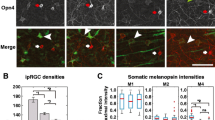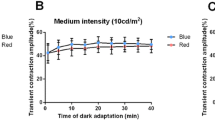Summary
-
1.
The photomechanical changes which occur inLimulus lateral eye during long-term (8 hours or longer) dark-light adaptation were studied via light microscopy.
-
2.
The results indicated that, in addition to the migration of protective pigment granules previously observed, morphological changes occur in cone cells, retinular cell rhabdomeral membranes and eccentric cell dendrites during adaptation (Figs. 1, 2 and 3). These changes were confined to the illuminated (or light-deprived) portion of the eye and did not depend on intact neural connections with the brain.
-
3.
Eyes excised during daylight hours from animals maintained in darkness appeared partially “light-adapted” suggesting circadian effects (Fig. 4).
-
4.
Large vacuole-Iike structures formed in retinular cells during prolonged (24–48 hour) exposure to fluorescent room light and disappeared during a subsequent dark period (Fig. 5).
-
5.
It is possible that the changes which occur in the rhabdomeral membranes of retinular cells and the eccentric cell dendrite during light-dark adaptation affect the electrotonic coupling which exists between these cells.
Similar content being viewed by others
References
Byers, B., Porter, K. R.: Oriented microtubules in elongated cells of the developing lens rudiment after induction. Proc. nat. Acad. Sci. (Wash.)52, 1091–1099 (1964)
Fahrenbach, W. H.: The morphology of the eyes ofLimulus. I. Cornea and epidermis of the compound eye. Z. Zellforsoh.87, 278–291 (1968)
Fahrenbach, W. H.: The morphology of the eyes ofLimulus II. Ommatidia of the compound eye. Z. Zellforsch.93, 451–483 (1969)
Fahrenbach, W. H.: The morphology of theLimulus visual system. IV. The lateral optic nerve. Z. Zellforsch.114, 532–545 (1971)
Horridge, G. A., Giddings, C.: The retina ofEphestia (Lepidoptera). Proc. roy. Soc. B179, 87–95 (1971 a)
Horridge, G. A., Giddings, C.: Movement on dark-light adaptation in beetle eyes of the neuropteran type. Proc. roy. Soc. B179, 73–85 (1971b)
Lüdtke, H.: Retinomotorik und Adaptationsvorgänge beim Rückenschwimmer (Notonecta glauca L.). Rev. suisse Zool.60, 528–534 (1953)
Miller, W. H.: Morphology of the ommatidia of the compound eye ofLimulus. J. biophys. biochem. Cytol.3, 421–428 (1957)
Miller, W. H.: Fine structure of some invertebrate photoreceptors. Ann. N. Y. Acad. Sci.74, 204–209 (1958)
Noell, W. K.: Aspects of experimental and hereditary retinal degeneration. In: Biochemistry of the retina (ed. by C. N. Graymore), p. 51–72. New York: Academic Press 1965
Noell, W. K., Albrecht, R.: Irreversible effects of visible light on the retina: Role of vitamin A. Science172, 76–80 (1971)
Satô, S.: Compound eyes ofCulex pipiens var.pollens Coquillett. (Morphological studies on the compound eye in the mosquito, No. I). Sci. Rep. Tôhoku Univ. (Biol.)18, 331–341 (1950)
Satô, S.: Structure and development of the compound eye ofCulex (Lutzia) vomx Edwards. (Morphological studies on the compound eye in the mosquito, No. VI). Sci. Rep. Tôhoku Univ. (Biol.)25, 99–110 (1959)
Satô, S., Katô, M., Toriumi, M.: Structural changes of the compound eye ofCulex pipiens var.pallens Coquillett in the process of dark adaptation. Sci. Rep. Tôhoku Univ. (Biol.)23, 91–99 (1957)
Schwartz, E. A.: Retinular and eccentric cell morphology in the neural plexus ofLimulus lateral eye. J. Neurobiol.2, 129–133 (1971)
Wada, S., Schneider, G.: Eine Pupillenreaktion im Ommatidium vonTenebrio molitor. Naturwissenschaften20, 542 (1967)
Walcott, B.: Movement of retinula cells in insect eyes on light adaptation. Nature (Lond.)223, 971–972 (1969)
Walcott, B., Horridge, G. A.: The compound eye ofArchiohauliodes (Megaloptera). Proc. roy. Soc. B179, 65–72 (1971)
White, R.: The effect of light and light deprivation upon the ultrastructure of the larval mosquito eye. II. The rhabdom. J. exp. Zool.166, 405–425 (1967)
Whitehead, R. A., Purple, R. L., Hopper, K.: The ultrastructure of the cornea-lens epidermis in the lateral eye ofLimulus polyphemus. J. Morph.129, 31–57 (1969)
Author information
Authors and Affiliations
Additional information
This investigation was supported in part by grant 5 RO1 EY 00236 from the National Eye Institute of the National Institutes of Health, U.S. Public Health Service, Department of Health, Education and Welfare.
Some of these experiments were performed in collaboration with Dr. Robert B. Barlow Jr., and Mr. Ehud Kaplan (Laboratory of Sensory Communications, Syracuse University, Syracuse, N.Y.). Dr. Barlow suggested the investigation of circadian changes in ommatidial morphology and he and Mr. Kaplan conducted the third of these series of experiments at the Marine Biological Laboratory, Woods Hole, Mass. They also prepared lateral eyes, excised from freshly collected crabs, for histological examination. The author is particularly grateful for many valuable discussions with Dr. Barlow and Mr. Kaplan and for their suggestions concerning the interpretation of the results.
I am deeply indebted to Dr. Verner Wulff for the many helpful suggestions he has made during the course of these investigations and for his able and willing assistance in the preparation of the manuscript. I thank Dr. Robert Barlow for his constructive criticism of the manuscript.
Rights and permissions
About this article
Cite this article
Behrens, M.E. Photomechanical changes in the ommatidia of theLimulus lateral eye during light and dark adaptation. J. Comp. Physiol. 89, 45–57 (1974). https://doi.org/10.1007/BF00696162
Received:
Issue Date:
DOI: https://doi.org/10.1007/BF00696162




